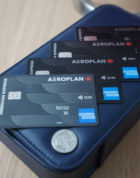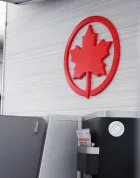Many airlines around the world allow passengers to place a bid to upgrade to a higher class of service before a flight. Travellers benefit from a more comfortable experience, and airlines benefit by generating additional revenue on what would otherwise be unsold inventory.
While paying cash for an upgrade doesn’t necessarily offer the same appeal as getting a “free” flight by using frequent flyer or credit card points, or by using eUpgrades on Air Canada flights, bid upgrades can still help you score a surprise upgrade for an affordable fee or save money if you were going to pay cash for a premium cabin ticket anyway.
How Do Bid Upgrades Work?
Interestingly, many air, cruise, and travel companies have partnered with Montreal-based Plusgrade to generate ancillary revenue from unsold space. Plusgrade handles upgrade requests through an online portal on behalf of the organizations, so the process of bidding for an upgrade will be nearly identical for all of their partners.
While the specific details for each airline may differ slightly, bid upgrades largely follow the same sequence of events:
- Book your flight
- Sign in to your booking and look for a “Bid Upgrade” option
- Enter your bid before the specified cut-off time
- Wait for notification that your bid has been accepted or declined, usually within 48 hours of departure
Though the process itself is relatively straightforward, there are some nuances about bid upgrades at each step along the way. Airlines don’t openly publish criteria for bid upgrades, but we can observe some tendencies about the process.
Not all fares are eligible for bid upgrades. Airlines reserve the right to modify the list of flights for which a bid upgrades are eligible. Most mention that bid upgrade eligibility depends on a variety of factors, including cabin class and seat availability.
In practice, this usually means that the lowest, most restrictive fare (“Basic” on Air Canada and WestJet) will not be eligible for a bid upgrade. This makes sense, as airlines would be able to generate more revenue from a higher fare with a bid upgrade or from a premium ticket in the first place.
Further, the range of prices for a bid upgrade depends on the original fare booked. Generally speaking, if you’ve selected a higher fare class, your range of bids is likely to be lower than if you selected a lower fare.
If your flight is eligible for a bid, after you have accessed the bidding portal you will notice a range of bids that are valid for your booking. Here, you’ll be able to see what the minimum and maximum bids for your flight are.

As shown in the above photo, you may also see the option to instantly confirm an upgrade at a set price. These tend to be at the higher end of the spectrum; however, if the upgrade is very important to you, at least you’ll know it’s a done deal.
Some airlines will also allow you to bid for an upgrade using frequent flyer points. On the bidding screen, there is a slider that allows you to choose between bidding with cash and points. Both Air Canada and WestJet allow this option.

Note that as you increase your bid, the “Offer Strength” meter (if present) will indicate the “odds” that your upgrade will clear. This is meant to make you feel more confident about spending more money, but in practice, don’t pay too much attention to it.
After you’ve submitted a bid, you can modify it up to end of the indicated bidding period. Shortly after the cut-off time, you will receive an email that states whether or not your bid was accepted.
If it was successful, your credit card will be charged. The bid upgrade fee is non-refundable, and doesn’t count towards your annual qualifying spend for elite status.
If it isn’t accepted, your credit card is not going to be charged, and you’ll remain in the same cabin as you originally booked.
Strategies for Bid Upgrades
As you can tell, playing the bid-upgrade game requires making a judgment call on how much you’d be willing to spend for an upgrade. And as a savvy Miles & Points enthusiast, this is also where a bit of research can help to guide your decision.
One of the many features in ExpertFlyer is the Flight Availability tool. Here, the relevant information is the number of seats available within each fare code.
Specifically, you’ll want to see how many seats are left for sale in business class (J, C, D, Z, P) and Premium Economy (O, E, A).

If there are a number of seats available for sale in the cabin to which you’d like to upgrade, then conventional wisdom suggests that you can place a lower bid and it is more likely to clear.
Likewise, if there are very few seats available, and if the upgrade is really important, then you would likely have to place a higher bid to increase the likelihood that it will clear.
Here is where timing can come into play, too. If you wait until close to the bid upgrade cut-off, you can have a good idea of where your bid will stand given the number of available seats remaining prior to the cut-off time.
With WestJet, upgrades can be made up to 75 hours prior to departure, and with Air Canada, you have up to 48 hours prior to departure.
Another commonly discussed strategy is to bid slightly above the lowest available bid. This assumes that anyone else placing a bid is likely to offer the lowest possible amount, and by bidding slightly up from the lowest bid, you increase the odds that the airline will take your bid offer over others’.
Finally, flying on a busy route, such as between Toronto and Calgary on a Monday morning, will lessen your chances of getting a good deal on a bid upgrade compared to flying at an off-peak time or route.
Are Bid Upgrades Worth It?
When combing through various online forums, you’re likely to come across a host of opinions on bid upgrades. Some people swear by them, claiming that they rarely pay for full business class fares.
Others mention that if a premium cabin is very important to them, such as for an international overnight flight, then they’d rather have a confirmed seat than taking a risk and waiting for the upgrade to be determined two days prior to departure. In these cases, they’re quite happy to pay more upfront for the premium seat.
Generally speaking, there’s some value to be found in bid upgrades. But this value is harder to pinpoint compared to, say, using Air Canada’s eUpgrades, as you can’t determine the range of bid values until after your booking is made.

Since most airlines offer a “cooling off” period after booking flights, which gives you 24 hours to cancel your booking without a fee, you could always make a booking, look at the bid upgrade options, and then cancel it. You could then book the same flights at a different fare to see what difference, if any, exists on the bid upgrade page.
However, this requires a lot of time and legwork, and you’d want to be 100% certain that you aren’t going to wind up with a booking that you don’t want.
With that in mind, bid upgrades can be a solid deal as long as the combined value of the bid upgrade and the original fare is moderately less than the cost of a paid business class fare. This is particularly so for long-haul flights, where having a lie-flat seat could mean the difference between arriving feeling somewhat rested and arriving feeling like you’ve been run over by a school bus.
Note that the terms from your original booking remain valid, even if your upgrade is accepted. This means that the refundability, mileage accrual, and change fees remain the same, even though you benefit from priority services, lounge access, increased baggage allowance, and an enhanced onboard service.
Crunching the Numbers
To better understand the potential value in bid upgrades, let’s take a closer look at the bid ranges on a sample Air Canada flight between Toronto and Vancouver. For the purpose of this exercise, let’s assume that the bid upgrade does eventually clear.
First, we’ll take a look at the bid ranges when using cash for different underlying fare classes, for an upgrade to business class.
Base Fare | Bid Range | Total Cost Range | Value Range | |
Standard | $161 | $440 – $1,000 | $601 – $1,161 | -$163 – $397 |
Flex | $180 | $440 – $1,000 | $620 – $1,180 | -$182 – $378 |
Comfort | $408 | $320 – $870 | $728 – $1,274 | -$276 – $270 |
Premium economy | $584 | $520 – $1,075 | $1,104 – $1,659 | -$661 – -$106 |
Business class | $998 |
As you can see, the range of bids is the same for Economy (Standard) and Economy (Flex) fares, which suggests that you stand to gain more with the lower fare to begin with if your upgrade were to clear. Of course, this doesn’t take into account other features of the fare that might be important to you, such as accrual of Aeroplan points and Status Qualifying Miles, amongst others.
Between Economy (Flex) and Economy (Comfort), the lowest bid decreases by $120, while the highest bids drop by $130. Both of these figures are more than made up for by the difference in base fare to begin with.
Oddly enough, the bid range for the Premium Economy (Lowest) fare is the highest amongst all the fares in this example.
If your upgrade were to clear, then you’d come out ahead by booking a lower fare and bidding at the lower range, while you’d wind up actually paying more with a higher bid than the cost of booking in business class to begin with.
Now, let’s take a look at the bid ranges when using Aeroplan points for different underlying fare classes, for an upgrade to business class.
Base Fare | Bid Range | Redemption Value | |
Standard | $163 | 44,000 – 100,000 | 1.9 – 0.84 |
Flex | $180 | 44,000 – 100,000 | 1.86 – 0.82 |
Comfort | $505 | 32,000 – 87,000 | 1.54 – 0.56 |
Premium economy | $584 | 52,000 – 107,500 | 0.8 – 0.39 |
Business class | $998 |
The above chart shows the cash fare, the cost in Aeroplan points to bid for an upgrade to business class, and the effective redemption value of those points based on the amount that the bid upgrade has saved you compared to the $998 business class cash fare.
As you can see, it’s possible to unlock a respectable redemption value of up to 1.9 cents per point (cpp) for your Aeroplan points by putting in a cheeky bid at the lowest end of the range and hoping that it clears. Of course, you can also get much worse value with a higher bid.
In any event, it’d be worthwhile to see how many points it costs to book business class to begin with, as you might wind up with significantly better redemption value this way.
Conclusion
Bid upgrades are offered on a host of airlines around the world. They are another tool for the savvy traveller to be seated in a higher class of service without paying full price.
Compared to booking premium cabins using frequent flyer miles or adopting the “Latitude Attitude” to confirm an upgrade on Air Canada, bid upgrades come with more risk as there is not a guarantee that your bid will be confirmed.
Therefore, bid upgrades can be seen as a useful tool for situations in which a premium seat isn’t “mandatory”. For example, for short- to medium-haul flights where sleeping isn’t required but a more comfortable seat, better food, sparkling beverages, and that delightful feeling of turning left after boarding sufficiently enhance the experience.





















Note: the cash that you pay in a bid upgrade does not count towards your SQD if you’re going for status.